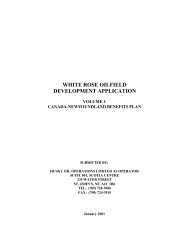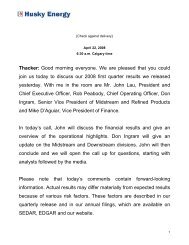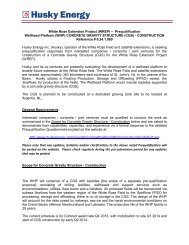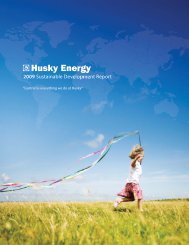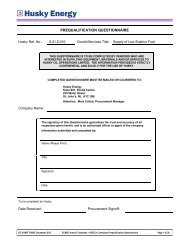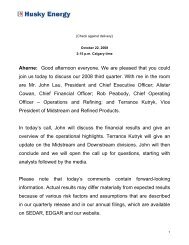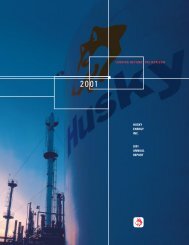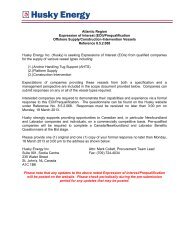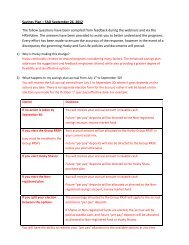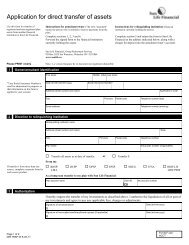white rose oilfield development application - Husky Energy
white rose oilfield development application - Husky Energy
white rose oilfield development application - Husky Energy
- No tags were found...
You also want an ePaper? Increase the reach of your titles
YUMPU automatically turns print PDFs into web optimized ePapers that Google loves.
<strong>Husky</strong> Oil conducted a baseline characterization program in the summer of 2000, consisting of abiological cruise in July and a sediment (benthic) cruise in September. The primary purpose of thebiological cruise was to collect American plaice and snow crab samples to conduct body burdenanalyses and multi-function oxygenase/histopathology/haemotology (in American plaice only). Snowcrab were selected due to the abundance indicated on the video tapes [see above]. American plaice wereselected as the species common to all three sites (White Rose, Terra Nova and Hibernia) to allow forpossible future common EEM programs; American plaice were also found to be numerous in the WhiteRose Area.The primary purpose of the sediment cruise was to collect sediment samples for chemistry and toxicityanalyses and identification of benthic infaunal invertebrates. Any epibenthic species on the surface ofeach core was identified. Water samples were also taken for chemical analyses at 25 percent of thesediment sample stations and conductivity-temperature at depth casts were taken at 50 percent of thesediment sample stations. The core samples were all sand, supporting the conclusion that the sedimentis very similar to Hibernia. The results identified during cruises were consistent with, and provideadditional validity for, data used in the EIS (Comprehensive Study Part One).In the event of a major oil spill, <strong>Husky</strong> Oil will also implement a dedicated EEM program to determinethe effects of any major spills, focusing primarily on marine birds, but also including fish and marinemammals. The structure of the monitoring program will follow the structure of the EEM programestablished for routine production activities at White Rose. The decision to implement such a programwill be made after consultation between <strong>Husky</strong> Oil and the C-NOPB, and will be based on thecircumstances of the spill. In addition, as per DFO’s Policy for the Management of Fish Habitat, anyhabitat compensation measures will be monitored and addressed.Compliance monitoring will be conducted to verify adherence with applicable legislation and conditionsof regulatory approvals. Compliance monitoring will primarily involve monitoring for conformance withthe discharge limits identified in the 1996 Offshore Waste Treatment Guidelines. Monitoring programswill be developed to measure and report on waste discharges that are treated according to the guidelines.5.3 Residual EffectsThe overall residual environmental effects of project <strong>development</strong> and operations on fish and fishhabitat, marine birds, marine mammals and sea turtles are assessed as primarily adverse, but notsignificant. There is also potential for some positive effects on fish and fish habitat. Predicted residualenvironmental effects associated with decommissioning are predicted to be positive for fish and fishhabitat and marine birds, marine mammals and sea turtles. For an accidental release of oil at the WhiteRose site, the predicted residual environmental effects on fish and fish habitat, marine mammals and seaturtles are adverse, but not significant. For marine birds, the predicted residual environmental effects ofan accidental oil spill are adverse and significant. While the probability of a major oil spill is very low,should one occur, it would have a significant adverse environmental effect on marine birds.White Rose DA Project Summary • January 2001 Page 81



